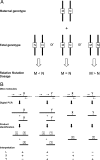Noninvasive prenatal diagnosis of monogenic diseases by digital size selection and relative mutation dosage on DNA in maternal plasma
- PMID: 19060211
- PMCID: PMC2596743
- DOI: 10.1073/pnas.0810373105
Noninvasive prenatal diagnosis of monogenic diseases by digital size selection and relative mutation dosage on DNA in maternal plasma
Abstract
Prenatal diagnosis of monogenic diseases, such as cystic fibrosis and beta-thalassemia, is currently offered as part of public health programs. However, current methods based on chorionic villus sampling and amniocentesis for obtaining fetal genetic material pose a risk to the fetus. Since the discovery of cell-free fetal DNA in maternal plasma, the noninvasive prenatal assessment of paternally inherited traits or mutations has been achieved. Due to the presence of background maternal DNA, which interferes with the analysis of fetal DNA in maternal plasma, noninvasive prenatal diagnosis of maternally inherited mutations has not been possible. Here we describe a digital relative mutation dosage (RMD) approach that determines if the dosages of the mutant and wild-type alleles of a disease-causing gene are balanced or unbalanced in maternal plasma. When applied to the testing of women heterozygous for the CD41/42 (-CTTT) and hemoglobin E mutations on HBB, digital RMD allows the fetal genotype to be deduced. The diagnostic performance of digital RMD is dependent on interplay between the fractional fetal DNA concentration and number of DNA molecules in maternal plasma. To achieve fetal genotype diagnosis at lower volumes of maternal plasma, fetal DNA enrichment is desired. We thus developed a digital nucleic acid size selection (NASS) strategy that effectively enriches the fetal DNA without additional plasma sampling or experimental time. We show that digital NASS can work in concert with digital RMD to increase the proportion of cases with classifiable fetal genotypes and to bring noninvasive prenatal diagnosis of monogenic diseases closer to reality.
Conflict of interest statement
Conflict of interest statement: F.M.F.L., N.B.Y.T., K.C.A.C., C.R.C., R.W.K.C., and Y.M.D.L. have filed patent applications on the detection of fetal nucleic acids in maternal plasma for noninvasive prenatal diagnosis. Part of this patent portfolio has been licensed to Sequenom. C.R.C. is chief scientific officer of and holds equities in Sequenom. Y.M.D.L is a consultant to and holds equities in Sequenom.
Figures

Similar articles
-
Noninvasive approaches to prenatal diagnosis of hemoglobinopathies using fetal DNA in maternal plasma.Hematol Oncol Clin North Am. 2010 Dec;24(6):1179-86. doi: 10.1016/j.hoc.2010.08.007. Epub 2010 Sep 29. Hematol Oncol Clin North Am. 2010. PMID: 21075287 Review.
-
Detection of fetal mutations causing hemoglobinopathies by non-invasive prenatal diagnosis from maternal plasma.J Postgrad Med. 2013 Jan-Mar;59(1):15-20. doi: 10.4103/0022-3859.109483. J Postgrad Med. 2013. PMID: 23525053
-
Noninvasive Prenatal Diagnosis of Beta-Thalassemia Disease by Using Digital PCR Analysis of Cell-Free Fetal DNA in Maternal Plasma.Fetal Diagn Ther. 2022;49(11-12):468-478. doi: 10.1159/000528033. Epub 2022 Dec 27. Fetal Diagn Ther. 2022. PMID: 36574763
-
Non-invasive prenatal diagnosis by single molecule counting technologies.Trends Genet. 2009 Jul;25(7):324-31. doi: 10.1016/j.tig.2009.05.004. Epub 2009 Jun 18. Trends Genet. 2009. PMID: 19540612 Review.
-
[Prenatal gene diagnosis of paternally inherited alpha-thalassemia by detecting fetal DNA in maternal plasma].Zhonghua Yi Xue Za Zhi. 2007 Jun 12;87(22):1540-4. Zhonghua Yi Xue Za Zhi. 2007. PMID: 17785106 Chinese.
Cited by
-
Free DNA--new potential analyte in clinical laboratory diagnostics?Biochem Med (Zagreb). 2012;22(1):24-38. doi: 10.11613/bm.2012.004. Biochem Med (Zagreb). 2012. PMID: 22384517 Free PMC article. Review.
-
Enrichment of the fetal fraction in non-invasive prenatal screening reduces maternal background interference.Sci Rep. 2018 Dec 5;8(1):17675. doi: 10.1038/s41598-018-35738-0. Sci Rep. 2018. PMID: 30518878 Free PMC article.
-
Transcervical retrieval of fetal cells in the practice of modern medicine: a review of the current literature and future direction.Fertil Steril. 2010 Apr;93(6):1725-30. doi: 10.1016/j.fertnstert.2009.11.022. Epub 2010 Jan 13. Fertil Steril. 2010. PMID: 20056202 Free PMC article. Review.
-
A Cell-free DNA Barcode-Enabled Single-Molecule Test for Noninvasive Prenatal Diagnosis of Monogenic Disorders: Application to β-Thalassemia.Adv Sci (Weinh). 2019 Apr 1;6(11):1802332. doi: 10.1002/advs.201802332. eCollection 2019 Jun 5. Adv Sci (Weinh). 2019. PMID: 31179213 Free PMC article.
-
New advances of preimplantation and prenatal genetic screening and noninvasive testing as a potential predictor of health status of babies.Biomed Res Int. 2014;2014:306505. doi: 10.1155/2014/306505. Epub 2014 Mar 24. Biomed Res Int. 2014. PMID: 24783200 Free PMC article. Review.
References
-
- Lo YMD, et al. Presence of fetal DNA in maternal plasma and serum. Lancet. 1997;350:485–487. - PubMed
-
- Lo YMD, Chiu RWK. Prenatal diagnosis: Progress through plasma nucleic acids. Nat Rev Genet. 2007;8:71–77. - PubMed
-
- Finning KM, Martin PG, Soothill PW, Avent ND. Prediction of fetal D status from maternal plasma: Introduction of a new noninvasive fetal RHD genotyping service. Transfusion. 2002;42:1079–1085. - PubMed
-
- Lo YMD, et al. Plasma placental RNA allelic ratio permits noninvasive prenatal chromosomal aneuploidy detection. Nat Med. 2007;13:218–223. - PubMed
Publication types
MeSH terms
Substances
LinkOut - more resources
Full Text Sources
Other Literature Sources
Medical

